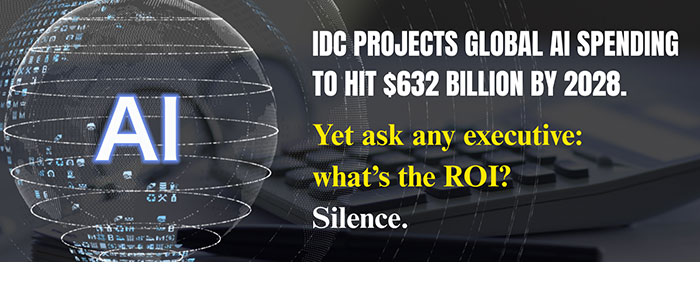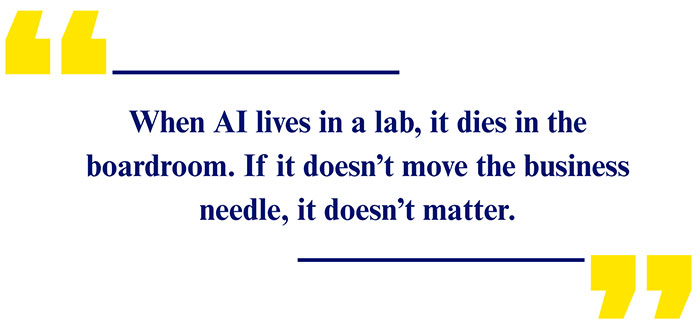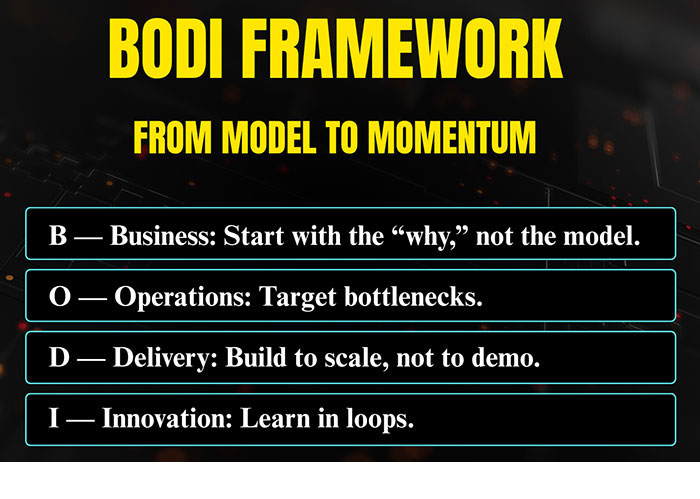Driving Innovation: A CEO’s Playbook for AI Adoption in Enterprises
If there’s one thing, I’ve learned helping enterprises adopt AI, it’s this: most companies are not failing at AI because of the tech, they’re failing because of the system around it.
Let’s face it. Enterprises have spent the last five years exploring AI in one way or another. They’ve launched pilots, built internal task forces, maybe even hired a Chief AI Officer. And yet, very few have crossed the chasm from experimentation to transformation.
According to McKinsey (2024), only 1 percent of company executives describe their gen AI rollouts as “mature.” Even though these remain early days for deployment, we are beginning to see the impact when these practices are employed to capture value.
That’s not a tech problem. That’s a leadership and systems problem.
The Illusion of Progress
AI is having a “cloud moment,” a buzzword with momentum but unclear returns. Most boardrooms are stuck in what I call purgatory. They’ve proven the concept but can’t prove the value. They’ve invested millions, but the business needle hasn’t moved.
So what’s going wrong?
The Enterprise AI Paradox: High Investment, Low Return
From where I sit, here’s what I see over and over:
- Business teams and data teams don’t speak the same language.
- Models are developed in silos, far from the workflows they’re meant to transform.
- Governance is reactive, not proactive.
- Innovation is treated like theatre demos, little deployment.
As I often say:
Let’s not confuse experimentation with execution. AI is not a project. It’s a systemic capability. And that requires a very different kind of thinking.
Introducing BODI: A Systems-Level Strategy for AI Transformation
At Nuvento, we’ve developed a strategy we call BODI, a structured way to turn AI from a buzzword into a business engine. It’s not a framework for models. We developed it as a blueprint for your business evolution.
Let me break it down.
B = Business: Start with the “Why”
This is the most common failure point. Too many AI projects start with a tool, not a tension. We flip that.
We ask:
- What business friction are we solving?
- Where’s the revenue uplift, the cost pressure, the risk?
- What outcome does the C-suite actually care about?
Start here, and you avoid the trap of building “cool tech” that no one uses.
“AI that doesn’t start with a business question ends as a technical distraction.”
O = Operations: Automate the Friction
Once we identify the “why,” we go looking for the how. Specifically, how can we use AI to smooth operations?
Not just automating tasks, but augmenting decisions.
Example: In one finance ops engagement, we used LLMs combined with structured data pipelines to reduce reconciliation time. That didn’t just improve efficiency. It improved accuracy and freed teams to focus on exceptions, not inputs.
This stage is all about making AI practical, grounding it in daily business friction, not hypothetical use.
D = Delivery: Industrialize the Deployment
This is where most AI initiatives stall. You’ve got the model. It works in a sandbox. Now what?
Without an enterprise-grade deployment pipeline, you’ll never get out of pilot mode.
We push clients to think in terms of:
- Reusable models across business units
- API-first architecture for flexibility
- MLOps maturity to monitor, manage, and evolve
Companies with mature MLOps practices experience 5x faster deployment cycles. That means more experiments, faster learnings, quicker wins.
I = Innovation: Build the Feedback Loop
AI isn’t “set it and forget it.” It’s a living system. Every model in production should teach you something, about your data, your workflows, your people.
But most companies run AI in sprints. Build-deploy-done.
At Nuvento, we build feedback loops into the system:
- What worked?
- Where did predictions miss?
- How do we close the gap?
This turns innovation from episodic to continuous. It’s not about building once. It’s about learning always.
Why BODI Works: It’s Designed for Complexity
Let’s not pretend otherwise: enterprises are layered, regulated, and often operate in silos.
Most AI approaches are too narrow for this complexity. BODI isn’t. It’s built for it.
It creates a common language between:
- Executives and data scientists
- Strategy and systems
- Vision and execution
BODI works because it respects the complexity while introducing clarity. And that’s the only way to drive sustainable transformation.
Toward AI-Native Enterprises
The next wave of winners won’t “use AI.” They’ll be AI-First, designed from the ground up to think, decide, and evolve with intelligence embedded.
What does that look like?
- Decision cycles that are measured in hours, not quarters
- Processes that adapt in real-time
- Employees who shift from doing to directing
- Strategy that’s fueled by insight, not gut feel
But this isn’t just about models. It’s about culture.
And that starts at the top.
CEOs need to stop mandating AI and start architecting intelligent cultures. Cultures where experimentation is safe, data is trusted, and systems are designed to learn.
“AI doesn’t transform your business, your systems, incentives, and mindset do. The model is just the spark. Real innovation is what you build around it.”
Stop Adding AI. Start Rethinking Systems.
BODI isn’t about adding AI. It’s about re-engineering how your enterprise senses, decides, and adapts.
Too many leaders still ask:
“What can AI do?”
It’s the wrong question.
Start asking:
“What system will let AI thrive?”
Because that’s where the real transformation happens. And that’s what we’re building at Nuvento.
Book a 1:1 session with me to discuss more about what AI can do for your business








